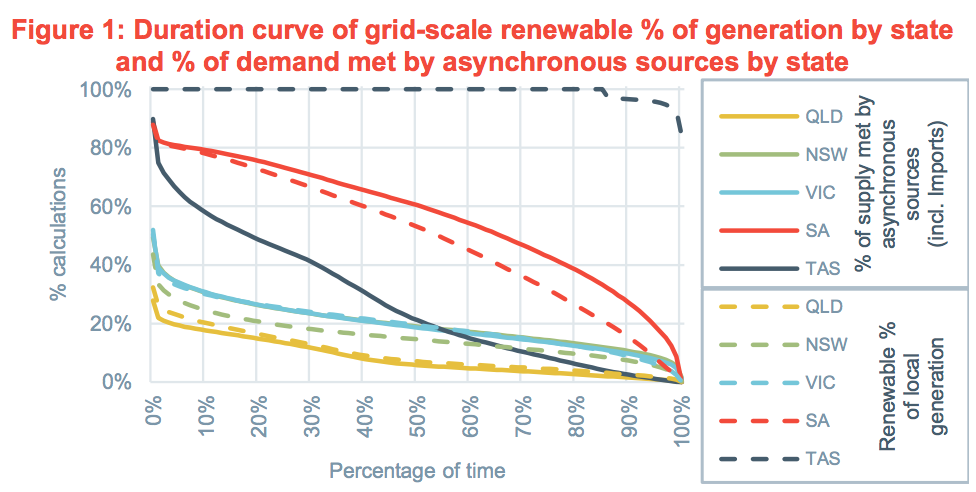While this challenge may not be as pressing for all NEM regions, the need to identify methods/ technologies to enable higher asynchronous generation is a welcomed objective in future proofing the NEM. To visualise the differences between regions in this transition, the chart summarises the last 18 months in the NEM into duration curves of the renewable percentage of local generation for each NEM region and the level of supply being supplied from asynchronous sources (this includes import volumes in the calculation). Behind-the-meter resources have been omitted from the analysis given the grid operation focus.
The significant presence of coal in the system for the foreseeable future means that the goal is not as pressing in QLD, NSW and VIC. It is also not as pressing for Tasmania which operates a mostly 100% renewable energy system. TAS is however increasingly incorporating higher asynchronous generation levels where 20% of the time, more than 50% of generation requirements come from asynchronous generation sources. However, the significant hydro capacity (i.e. synchronous gen) in the region means that TAS can have its cake and eat it too.
The region which is most of interest is South Australia. To be clear, SA is already on the cusp of 100% instantaneous renewable power. Over the last 18 months, local grid-level renewables have exceeded local SA demand in ~13k dispatch intervals (~8% of the time). However, despite this, AEMO still rely on gas generation in the state as the key to system stability. At a minimum there is at least 250 MW of gas generation online regardless of VRE penetration. So, the crux of AEMO’s 2025 goal is to remove the necessity to direct thermal units to remain online for system strength. New synchons in the state should reduce the need for SA gas units to remain online as well as announcements for large grid-forming batteries like from AGL.
However, the capability is a first but important step. The key question then is when AEMO would then have the operational confidence to reliably operate the grid with 100% instantaneous power from asynchronous sources. South Australia likely becomes the NEM’s proving grounds for these new operational approaches (if it wasn’t already).
It is likely that system-level observations would be required as well as the presence of additional service support such as increased local FCAS provision or grid forming types of technologies. It also means that the definition and quantification of the largest contingency likely evolves from the loss of the largest single unit to the expected forecast change in VRE sources. It is unclear how this level would compare to the status quo but what is clear is that this would be a different operating paradigm for AEMO.
While the current focus on supporting 100% instantaneous renewable power is a key challenge, a similar effort should be aimed at the inverse case – particularly without coal in the system. Granted this challenge is likely to be more pressing later in the decade, it still requires attention in the near term to understand what level of dispatchable generation is required (to allow for sufficient investment and planning). As we know from recent experience (COTW #92), VRE droughts are a somewhat regular occurrence, and it is important that there is enough backup on the system to handle prolonged events effectively.
–
Author: Jake Dunstan is lead analyst at Cornwall Insight Australia.
The views and opinions expressed in this article are the author’s own, and do not necessarily reflect those held by pv magazine.
This content is protected by copyright and may not be reused. If you want to cooperate with us and would like to reuse some of our content, please contact: editors@pv-magazine.com.








By submitting this form you agree to pv magazine using your data for the purposes of publishing your comment.
Your personal data will only be disclosed or otherwise transmitted to third parties for the purposes of spam filtering or if this is necessary for technical maintenance of the website. Any other transfer to third parties will not take place unless this is justified on the basis of applicable data protection regulations or if pv magazine is legally obliged to do so.
You may revoke this consent at any time with effect for the future, in which case your personal data will be deleted immediately. Otherwise, your data will be deleted if pv magazine has processed your request or the purpose of data storage is fulfilled.
Further information on data privacy can be found in our Data Protection Policy.